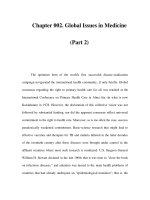Final napsac tor 002 1
Bạn đang xem bản rút gọn của tài liệu. Xem và tải ngay bản đầy đủ của tài liệu tại đây (231.95 KB, 7 trang )
Final agreed
Terms of Reference
National Patient Safety Alert
Committee (NaPSAC)
Document filename: Terms of reference
Directorate/ programme NHS Improvement
Project
Creating a credentialing
system for Patient
Safety Alerts
Lead
Dr Aidan Fowler
Status
FINAL
Owner
Dr Frances Healey
Dr Matt Fogarty
Version
V2.1
Author
Dr Frances Healey
Dr Matt Fogarty
Version issue date
31/08/2018
Document management
Revision history
Version
Date
Summary of changes
V.1.0
23/03/18
Initial Draft Document for Review (background, proposal and ToR)
V. 2.0
06/08/18
Revised ToR
V. 2.1
31/08/18
Revised ToR after minor comment at 14/08/18 NaPSAC
Reviewers
This document must be reviewed by the following people:
Reviewer name
Title/responsibility
Date
Dr Aidan Fowler
NHS National Director of Patient Safety,
NHS Improvement
Dr Kathy McLean
Executive Medical Director, NHS
Improvement
Version
Approved by
This document must be approved by the following people:
Name
Mr Aidan Fowler on
behalf of all members of
NaPSAC
Signature
Title
Date
Version
NHS National
Director of Patient
Safety, NHS
Improvement
Document control
The controlled copy of this document is maintained by NHS Improvement. Any
copies of this document held outside of that area, in whatever format (e.g. paper,
email attachment), are considered to have passed out of control and should be
checked for currency and validity.
2
Contents
Document management
2
Contents
3
1
Background
4
2
Purpose of NaPSAC
4
3
Scope of NaPSAC
5
4
Operating NaPSAC
5
Membership of NaPSAC
5
6
Accountability
6
7
Ways of working
7
Error! Bookmark not defined.
3
1 Background
The core purpose of NaPSAC is to agree, progress and oversee systems
which will clearly identify which nationally-issued patient safety advice and
guidance is safety-critical.
This clarity is important for increasing providers’ understanding about which
safety-critical actions must be implemented by them. It is also an essential
precursor to more effective systems through which compliance can be robustly
monitored.
The focus of NaPSAC is on ensuring common standards and thresholds in the
processes by which each and every ‘authorised’ body designates any of their
communications as a ‘nationally credentialed patient safety alert’. The urgency
of many patient safety issues means it would not be realistic for the
overarching body to approve the designation of individual Alerts before they
are issued.
2 Purpose of NaPSAC
NaPSAC has been established to design and become the body with
responsibility for ensuring the clarity and efficacy of communication that will
enable providers to recognise and implement safety-critical actions
It will operate on a membership and mutual basis to:
Develop the ways of working by which NaPSAC that ‘authorises’ National
Patient Safety Alert issuing bodies
Agree and maintain membership of NaPSAC, including membership from all
nationally credentialed patient safety alert-issuing bodies, and others as
agreed
Agree its own ways of working
Agree and maintain the mechanism for designating bodies so they are
authorised to issue ‘nationally credentialed patient safety alerts’ and the
associated systems for maintaining and if necessary withdrawing
authorisation.
Agree and maintain the criteria for issuing a ‘nationally credentialed patient
safety alert’ that specifies mandatory safety-critical actions that must be taken
by healthcare organisations.
4
Agree and maintain the criteria for any sub-types of ‘nationally credentialed
patient safety alert’, and ensure these sub-types relate only to logistics of
organisational response, rather than suggest ranking of importance (as by
definition all are mandatory and safety critical)
Agree and maintain the title, form and format for ‘nationally credentialed
patient safety alerts’
Agree the route(s) of communication and dissemination of ‘nationally
credentialed patient safety alerts’
Agree the mechanism for self-reporting of compliance with ‘nationally
credentialed patient safety alerts’ by organisations
Agree ‘go live’ date for the ‘nationally credentialed patient safety alert’ system
Advise on the approach of regulators and other supervisory bodies to
regulating compliance with ‘nationally credentialed patient safety alerts’
Periodically review how these arrangements are operating
3 Scope of NaPSAC
NaPSAC is focused on communications directed at organisations and
requiring specific coordinated organisational action by a specified date to
address risks that are life-threatening or involve risk of disability to patients.
The work of NaPSAC explicitly excludes non-safety critical communications,
guidance that does not require action to be completed by a specified date,
information directed at individual healthcare staff (i.e. informative ‘safety
messages’), or risks to staff or the public.
NaPSAC would operate in England only, and efforts to align Alerts across the
UK would continue to be led by MHRA in the broad sense, and also
progressed by specific alert-issuing bodies in England
NaPSAC will not be responsible for the commissioning or delivery of technical
platforms for disseminating ‘nationally credentialed patient safety alerts’ and
collecting subsequent responses from providers on action taken, other than as
described in 2.10
4 Membership of NaPSAC
NaPSAC will be chaired by the NHS National Director of Patient Safety (as
already decided by Secretary of State).
5
The NaPSAC Deputy Chair will be the CQC Chief Inspector of Hospitals (as
already decided by Secretary of State).
NaPSAC membership will include relevant individuals from each of the
‘nationally credentialed patient safety alert’ issuing bodies. These individuals
must be authorised to take decisions on behalf of their body/team in relation to
this work. The following bodies/teams are initially represented at NaPSAC on
the basis that they either currently directly issue safety messages via CAS or
intend to develop the facility to do so:
NHS Improvement’s Patient Safety Team
NHS Improvement’s Estates and Facilities Team
MHRA Devices
MHRA Drugs
DHSC Supply Disruption
Public Health England
NHS Digital
Office of the Chief Medical Officer
NHS England Primary Care Operations
NHS England Emergency Preparedness & Response
NaPSAC patient and public representation is initially proposed as two PPV;
this would be kept under review
NaPSAC would also have membership from groups who do not issue Alerts
but have a key interest in ensuring the Alerting system is effective. These are
currently covered by the membership above, but would be kept under review
The devolved nations have an interest in the work of NaPSAC in so far as this
has implications for the devolved nations. Invitation as observers will be
extended to each of the three devolved nations (one observer per nation)
NaPSAC coordination and secretariat would be provided by the NHS
Improvement Patient Safety team (as already decided by the Secretary of
State)
5 Accountability
NaPSAC’s route of accountability is to the National Quality Board, subject to
confirmation at a future NQB
6
6
Ways of working
NaPSAC will determine its own ways of working but these initially include the
following:
To be quorate, NaPSAC must include the Chair or their Deputy and two thirds
of members
NaPSAC will meet quarterly initially, and at intervals it determines appropriate
thereafter, with meeting dates agreed at least 2 months in advance
Papers and items will be circulated 5 working days in advance of meetings.
Late papers will not be considered unless otherwise agreed with the Chair.
Agendas, minutes and papers will be published unless this is not possible
without breaching information governance and confidentiality duties.
7









